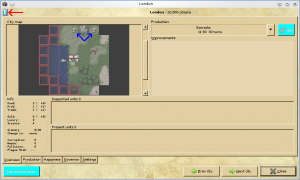 The most important thing to do in the start of the game is selecting best places for your first cities.
The most important thing to do in the start of the game is selecting best places for your first cities.
Also usually the best strategy in the start is to optimize to expand by building new cities.
In LT30 you have four settlers, two explorers and two workers in the beginning. Cities can use 7×7 tiles around the city center (except the corners) but only if you have vision to them. Empty cities have vision of standard 5×5 land.
First you should use your explorers to search the lands around your starting place to have better knowledge of your surroundings.
You start with a Despotism government style and because of that those tiles get -1 penalty of more or equal to 3 resources. For example you will get only 2 food from Ocean (Fish) or Plains (Wheat) instead of normal 3. However by irrigating the Wheat tile, you may get three food even in the despotism.
Each city center will get at least one more of each resource — it’s actually a bit more complicated than that. For example if you build your city to Plains, the city center will generate 2 food, 1 shield and 1 trade (instead of 1/1/0), which is the same if you build it on a Grassland tile. However a city center on mountains will get 1 food, 1 shield and 1 trade (instead of 0/1/0).
You should select a place where you get maximum food output from at least two tiles (including the city center) and use your workers to maximize it (see the blue arrow in the image). That way you get your city to grow faster and you can build new cities faster. It helps if those tiles have shield output. Good optimized compromise to get fast growing cities is two irrigated Plains and a city center on Grassland or Plains tile, because with Granary built it gives you a city that grows and builds settler every 5 turns. It’s even faster if you have irrigated Oasis or Grassland tiles that give you output of three food each turn each tile.
You need to research Pottery to build Granary. Select it from Cilization -> Research (F6). In the start the fastest way to research bulbs is to change your people in the cities as scientists by removing them from the tiles and clicking the icon for specialist (see the red arrow in the image). Another option is to use GMA and select the Max Science governor.
This should give you 3–4 bulbs in each of your city (total about 16 each turn) and you can develop Pottery in only 4–5 turns.
While waiting the Pottery you can start building Barracks in the cities and once Granary is available you can change it to Granary. Just make sure you don’t complete the Barracks before you have Granary available. Also use your workers to irrigate one or two good food tiles near your city.
Without a Granary your cities will not grow as fast. The food stock is reduced to 0 when a city changes it’s size. With a Granary it will be half of the stock which makes growing to a new size half times faster.
